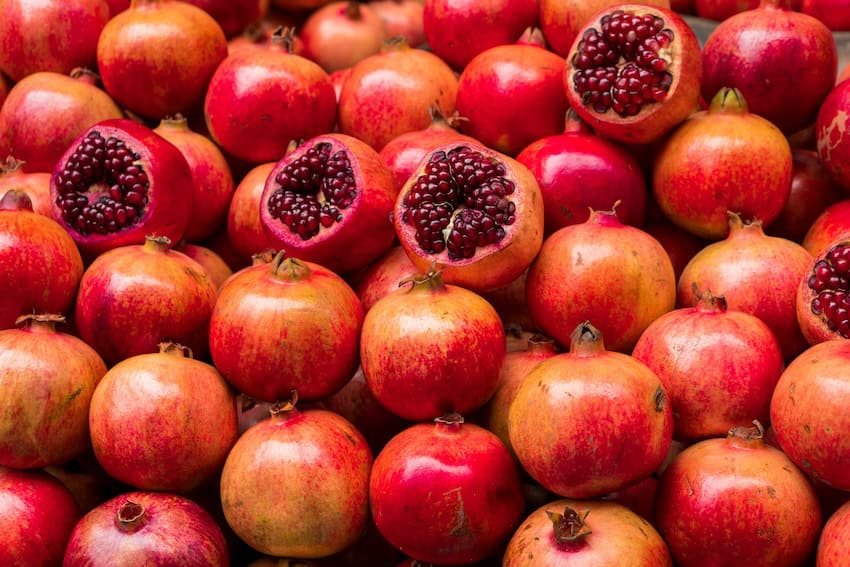For once, I’m going to write about a fruit whose history is refreshingly unconnected to ancient Mexico. The pomegranate hails from a stretch running through modern Iran to the northern reaches of the Indian Himalayas. Archaeological finds tell us that people in these regions cultivated and savored the fruit as far back as 5,000 years ago.
The pomegranate’s journey reads like a footnote to the great travelogues of civilization. Phoenicians — master navigators and merchants whose legacy includes the alphabet — spread pomegranate seeds from the Levant to the Mediterranean’s edge, long before Rome would see its first triumph. Their ships mapped new routes for culture and cuisine throughout Asia, Europe, and North Africa. Later, when the Moors conquered the Iberian Peninsula, they brought their gardens with them, including the pomegranate, to the Andalusian sun. Granada, one of Spain’s most exquisite cities, still bears the fruit as its emblem.

The final lap of its journey took place with the Spanish conquest of the Americas. Galleons laden with goods — gold, spices, dreams, and seeds — sailed west, carrying pomegranates into the New World, where the fruit found new soil and eventually, a starring role in Mexico’s culinary heritage.
As for the word itself, “granada” comes from the Latin malum granatum (“seeded apple”), revealing how ancient cultures viewed the pomegranate as both familiar and mysterious —so much so that it couldn’t help but attract legend.
For Egyptians, pomegranates were important enough to be placed in tombs for the afterlife, prized for their healing powers and as a source for textile dyes. The Babylonians believed eating the fruit before battle guaranteed good luck and courage. Greeks regarded the pomegranate as an aphrodisiac, weaving the fruit into their mythology — the story of Persephone’s descent into the underworld is marked by the fateful moment she ate its seeds.
Judaism holds that the fruit’s many seeds represent the 613 commandments of the Torah, adorning priestly robes and Temple pillars. Early Christians viewed it as a symbol of harmony, and in Islam, it is counted among the fruits of paradise, with pomegranate trees still grown in gardens as reminders of abundance and divine favor. Across generations and faiths, its symbolism endures.
Personal symbolism
At my grandparents’ ranch, a pomegranate tree dominates the center of the patio. Each year, as the fruit ripened, my grandfather would organize our harvest. Hands stained, clothes splattered with the indelible red juice, we’d gather beneath its branches to peel away the rind, gossiping and sharing stories until the sunset colored the sky. There, plans were made: quesadillas in the village, borrowing a neighbor’s stew, or simply playing rummy with fresh bread and milk at home. For me, the pomegranate tree is a symbol for enjoying a perfect moment of “dolce far niente” — sweet nothingness — after a day of hard labor.
Pomegranate in Mexican kitchens
Curiously, Mexican kitchens have rarely adopted pomegranate outside of one iconic dish. Unlike the sugar-crystallized candies, jams, or preserves made from other fruits, pomegranate’s role has been almost entirely reserved for chiles en nogada. This celebratory plate — white walnut sauce, green poblano pepper, and the brilliant red of pomegranate seeds—was invented to commemorate Mexico’s independence. It’s claimed the dish uses exclusively endemic ingredients from Puebla. Whenever I hear this strong affirmation, it makes me smile. Here is a fruit from Persia, chosen to represent the red of our flag, echoing the blood of independence fighters, yet a world away from Mexican origin.
Outside this symbolic role, pomegranates appear from August to October, filling market stands with granadas, some cut open to display their ruby grains. Street vendors roam, selling them whole, in simple sacks, or freshly seeded.
If you ask me, the simplest way is the finest: devour them as they are, sun-warmed and pure, or with a hint of salt and lime to accent their natural sweetness.
A powerhouse hidden in plain sight
Pomegranate isn’t just beautiful; it’s remarkably nutritious. Each seed is loaded with polyphenols, tannins, vitamins C and K, folate, potassium, and a good dose of fiber. If you’re chasing antioxidants, pomegranate outperforms even green tea.
Its benefits are wide-ranging and backed by growing scientific interest: potentially helping prevent certain cancers, improving cardiovascular health, lowering blood pressure, boosting cognitive function and aiding in the prevention of Alzheimer’s, strengthening the immune system, and serving as an impressive anti-inflammatory agent — especially for those with arthritis. Some even call it a fountain of youth, thanks to its antioxidant compounds.
Reinventing tradition
These days, Mexican cooks are experimenting with pomegranate. It’s no longer confined to chiles en nogada or the market vendor’s buckets. Toss the seeds into salads. Try them with chickpeas, tomatoes, olives, red onion, a splash of olive oil, and a little vinegar. The freshness is unmistakable, the pop of flavor unforgettable.
The next time you eat chiles en nogada, reflect on what each bite delivers: the taste of Persian orchards, Phoenician spice ships, Moorish palaces, Spanish colonial ambition, and Mexican creativity. The pomegranate, in every seed, carries a vertical slice of world history — its crimson hue a reminder of the way our plates are shaped by journeys both ancient and ongoing.
María Meléndez is a Mexico City food blogger and influencer.




